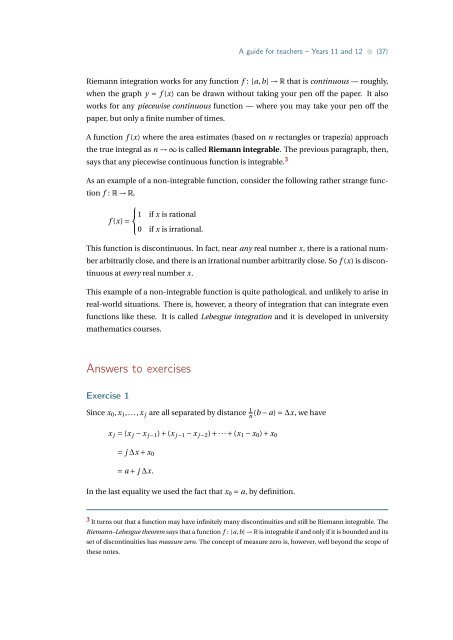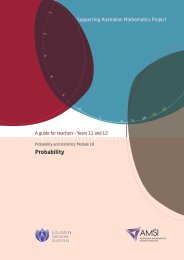Integration - the Australian Mathematical Sciences Institute
Integration - the Australian Mathematical Sciences Institute
Integration - the Australian Mathematical Sciences Institute
You also want an ePaper? Increase the reach of your titles
YUMPU automatically turns print PDFs into web optimized ePapers that Google loves.
A guide for teachers – Years 11 and 12 • {37}Riemann integration works for any function f : [a,b] → R that is continuous — roughly,when <strong>the</strong> graph y = f (x) can be drawn without taking your pen off <strong>the</strong> paper. It alsoworks for any piecewise continuous function — where you may take your pen off <strong>the</strong>paper, but only a finite number of times.A function f (x) where <strong>the</strong> area estimates (based on n rectangles or trapezia) approach<strong>the</strong> true integral as n → ∞ is called Riemann integrable. The previous paragraph, <strong>the</strong>n,says that any piecewise continuous function is integrable. 3As an example of a non-integrable function, consider <strong>the</strong> following ra<strong>the</strong>r strange functionf : R → R,⎧⎨1 if x is rationalf (x) =⎩0 if x is irrational.This function is discontinuous. In fact, near any real number x, <strong>the</strong>re is a rational numberarbitrarily close, and <strong>the</strong>re is an irrational number arbitrarily close. So f (x) is discontinuousat every real number x.This example of a non-integrable function is quite pathological, and unlikely to arise inreal-world situations. There is, however, a <strong>the</strong>ory of integration that can integrate evenfunctions like <strong>the</strong>se. It is called Lebesgue integration and it is developed in universityma<strong>the</strong>matics courses.Answers to exercisesExercise 1Since x 0 , x 1 ,..., x j are all separated by distance 1 n(b − a) = ∆x, we havex j = (x j − x j −1 ) + (x j −1 − x j −2 ) + ··· + (x 1 − x 0 ) + x 0= j ∆x + x 0= a + j ∆x.In <strong>the</strong> last equality we used <strong>the</strong> fact that x 0 = a, by definition.3 It turns out that a function may have infinitely many discontinuities and still be Riemann integrable. TheRiemann–Lebesgue <strong>the</strong>orem says that a function f : [a,b] → R is integrable if and only if it is bounded and itsset of discontinuities has measure zero. The concept of measure zero is, however, well beyond <strong>the</strong> scope of<strong>the</strong>se notes.
















